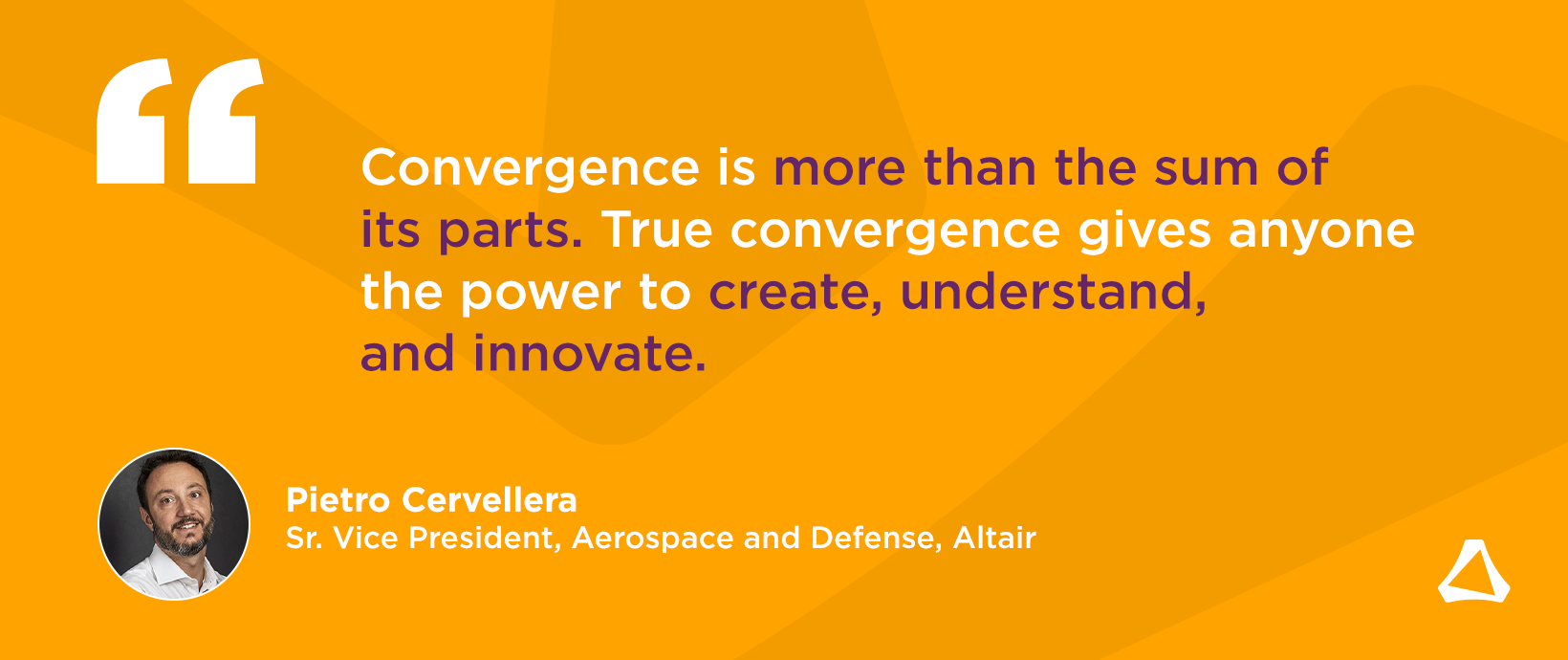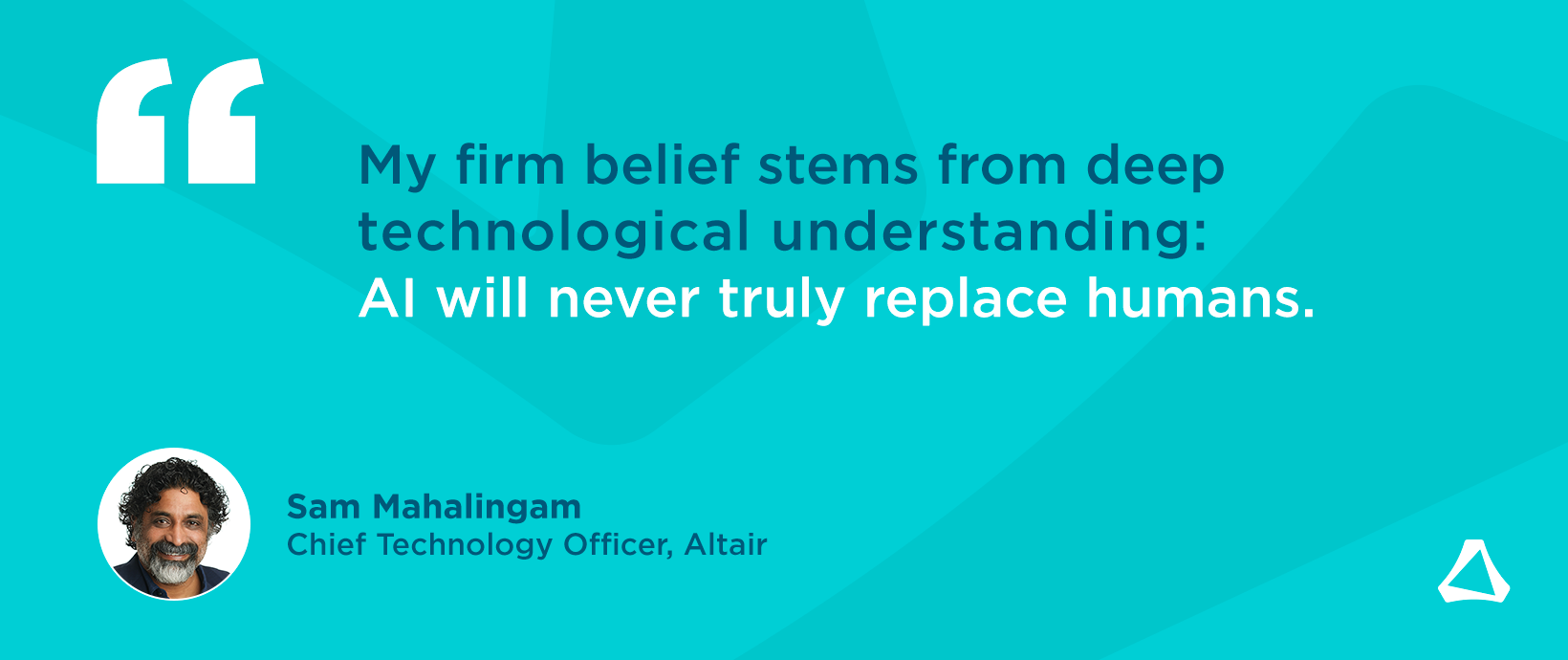Data, Convergence, and the Future of Aerospace Innovation

For many, the aerospace industry has always been at the forefront of innovation. It’s the industry that gave us flight, took us to the moon, and revealed the wonders of the universe around us; and in doing so, it helped us better understand our world. But as our world becomes more and more digital – accelerated by the dramatic increase of data and the accompanying rise in the use of data analytics – we are facing new, unique challenges. How can we adopt these revolutionary new technologies quickly, while still ensuring we achieve the highest quality and safety standards, and ever-expanding sustainability targets?
In essence, everyone’s trying to use data – both historical and synthetically generated data – to better understand how products and processes will behave before they make it into the real world. The same is true in the aerospace industry. With data, aerospace companies can predict a multitude of things, like how a plane will behave in the air, how different materials impact weight and durability, how new designs will impact performance, and much more. This means that, rather than relying on physical prototyping and field tests, teams can understand how their product will perform with greater accuracy than ever thanks to virtual testing and data. And with the powerful data and simulation tools at engineers’ disposal today, we can use data not just in a predictive manner, but in a prescriptive manner. This presents an invaluable opportunity for aerospace innovation and technological transformation on a mass scale.
As aerospace engineers and designers know, there is no such thing as a panacea. Data is no exception – it can’t do much by itself. But paired with game-changing artificial intelligence (AI)-powered simulation design tools and flexible, scalable high-performance computing (HPC) resources, engineers can realize capabilities of which they’ve only dreamt. This is Altair’s convergence vision – a future in which data, simulation, AI, and HPC coalesce to create unheard-of potential for innovation and design freedom.
In this essay, I’ll explore the concept of technology convergence, the transformative impact it can have on the aerospace industry, and how properly managed data is an essential part. I'll also dive deeper into how Altair is making it easier to adopt and scale the concept of convergence through the democratization of data analytics.
The Three Pillars of Convergence
We’re undoubtedly in the midst of a data revolution, one that has already reshaped the world. The prevalence of more and better data analytics technology – including better software and visualization tools, more efficient ways of storing data, more dedicated data scientists, and beyond – has fundamentally changed the ways we live and work. Data has been a large part of the aerospace industry since its inception. One can’t send passengers 40,000 feet into the sky, much less beyond the Earth’s atmosphere, without being confident that your craft is safe and secure. Data delivers that reassurance.
The aerospace industry is also no stranger to simulation and design software. In fact, the core principles of today’s leading simulation technology originated in aerospace. Simulation’s role in the aerospace industry is straightforward. Take collision testing, for example. Imagine trying to replicate the impact of a bird strike on an airplane, and needing to build – then intentionally damage – 100 functioning engines to do so! There would be a lot of inefficiencies in that process from a time, resource, and financial standpoint. Simulation technology is the natural solution.
HPC is the third pillar of convergence. The ability to leverage the ever-growing computational power of IT infrastructures and the cloud is the thread that ties data and simulation together, and allows organizations and teams to run, access, store, and implement it all. There’s no true convergence without capable, scalable HPC. It’s the great enabler.
But convergence is more than the sum of its parts. Simply having these three aspects separately doesn’t constitute a convergence approach – how they interact is the differentiator.
Convergence is the process of interweaving the three pillars – data, HPC, and simulation – to the point where the boundaries between each fade away. When terabytes of historical data are woven seamlessly into simulation tools that generate recommendations for part shape, material, and position based on that data, that’s convergence. When engineers have the computing power to run hundreds of thousands of real-time simulations to better understand how an aircraft will respond to strong turbulence – by using real atmospheric and craft data stored in the cloud – that’s convergence. When engineers, data scientists, designers, and other users of any skill level – from novice to expert – can use the same tools and glean insights in a single, unified environment with shared interfaces and functionalities, that’s convergence.
A true convergence approach gives anyone within an organization, no matter their domain or skill level, the power to create, optimize, understand, and innovate. This is the essence of democratization.
Democratizing Convergence
Many of the world’s leading organizations have already implemented this convergence approach to great effect. But there’s one sticking point: most organizations don’t have the resources that allow them to maximize their data’s potential. This is mostly due to a lack of data science talent, which is a worldwide issue. Simply put, not even the world’s best companies have enough dedicated data scientists to satisfy demand. And without a lot of organized, high-quality data, simulation and HPC can only do so much. As organizations on the vanguard of the possible, aerospace companies aren’t content to settle. But how can they maximize their data potential when each individual data scientist supports hundreds of engineers?
This is where democratization makes all the difference. If convergence is the “what,” democratization is the “how.” Altair’s technology allows data scientists and engineers to break free of their traditional domains and specialties so they can access new insights in quick, intuitive ways. For example, no longer do engineers need to wait for the data team to create models and interpret data – with Altair tools, engineers can access intuitive, no-code data science platforms that allow them to run and execute models from any device they choose. Projects and insights that used to take months can now take days or even less – all without needing to coordinate between departments, time zones, etc. This is a transformational proposition, especially for an industry so used to dealing with long lead times amidst a shifting technology landscape.
By having simple, accessible, intuitive tools, this approach is also scalable. Altair can put powerful data and simulation tools in the hands of people who benefit from these things but have not previously had an easy way to access insights or perform the associated functions themselves. Now, an engineer doesn’t need to have decades of high-level coding experience to run machine learning models – all they need is a quick rundown of Altair RapidMiner, our data analytics and AI platform, and its basic no-code functions. This is the definition of applied convergence – data and engineering domain science exemplified in one user, scaled across entire organizations.
Convergence for Good
I find convergence so exciting because of its potential to help companies do immense good. Within the aerospace industry, the convergence of simulation, HPC, and AI can have an immediate impact. First (and perhaps most importantly for businesses) it will help organizations make better products faster. The aerospace landscape of the 2020s is not the aerospace landscape of the 1970s. The increasing privatization of aerospace means the pace of innovation is accelerating. Convergence will allow companies to better stay up to date with market trends and put more compact, more efficient payloads into space. It will also help them reduce costs and minimize risk, two vital factors within any industry.
But more broadly, it will open avenues to insights and innovations that will help us understand our world and our place within it – what aerospace has done at its best since the beginning. It will allow us to design safer, more efficient aircraft; develop better satellites; better monitor emissions, animal populations, forests, sea ice, and ocean currents; better predict how changes in our atmosphere affect the environment; and so much more. Convergence will help aerospace solve its own internal challenges – and in doing so, help the industry better play its part in the story of human progress.
Conclusion
I’m proud of the work we do at Altair because we’re making an impact worldwide. Altair is tireless in our quest for innovation. We never rest, never get stuck in our ways or habits. We’re never complacent with our technology or our customer relationships. We know the stakes are high. Our vision is something that motivates us to do great work and deliver world-changing innovation that can enable our customers to do extraordinary things. I look forward to seeing convergence come to life through the power of democratization, and I look forward to doing it, as always, side by side with our customers.
Visit the following links to learn more about Altair’s aerospace and defense capabilities.




